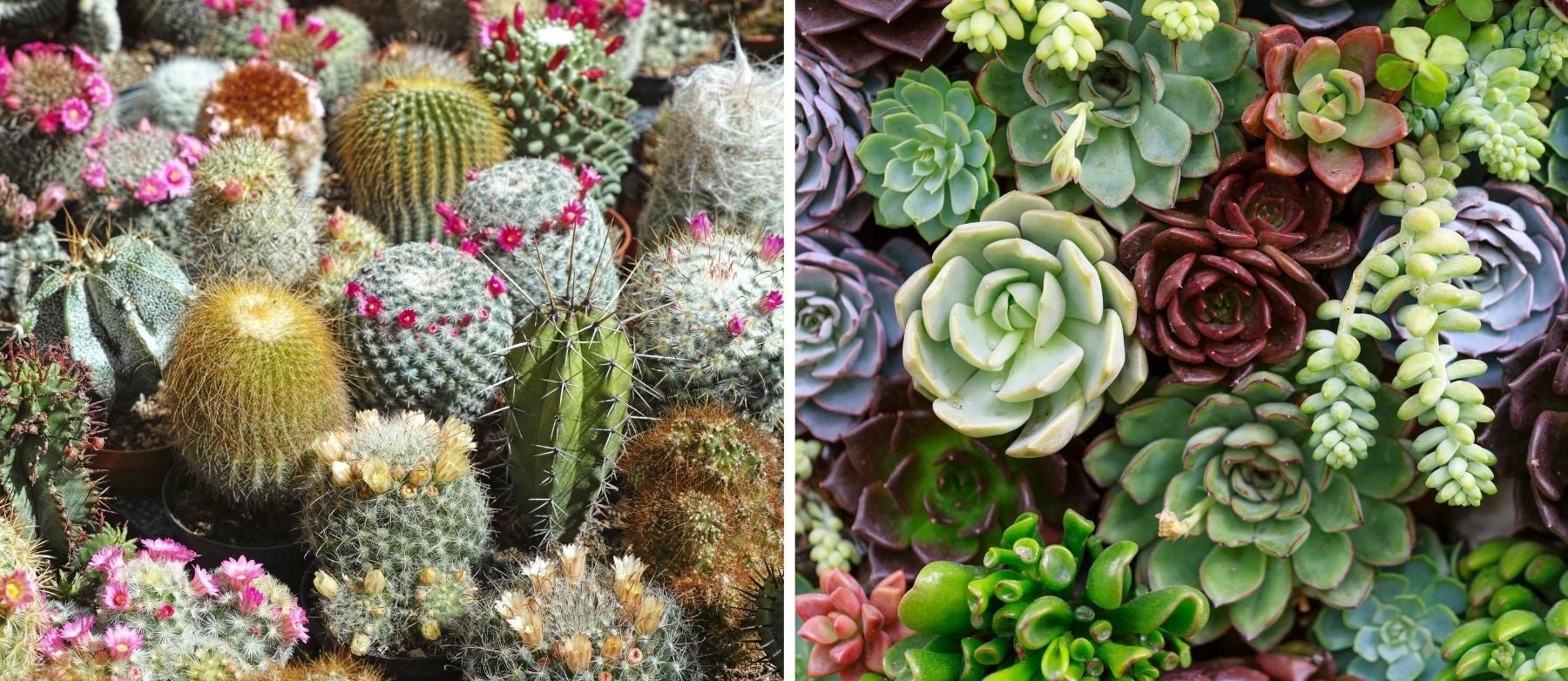Are you wondering how to water a succulent without harming it? Do you want to know how to tell if your plant is thirsty?
I will help you.
Succulents are very sensitive to overwatering. They are quite beautiful, but they require some knowledge of care in order to thrive and even produce lovely blooms.
Today, I’m sharing my floristry skills with you so that you can take care of your succulents in the best way possible, watering them without harming them and even creating wonderful arrangements like flower crowns.
Succulents and cacti are uniquely resistant to drought and don’t tolerate excess water very well. To avoid harming your plant by overwatering, I recommend checking that the soil is completely dry before watering, and make sure not to let the roots sit in water. One effective method is to soak your pots in a basin filled with rainwater: this allows for watering through capillarity. Avoid spraying water, as it could cause the plant to rot. Lastly, reduce or even stop watering during the winter.
Want to learn more? Keep reading to discover:
- How to identify a succulent
- How to tell if your succulent is thirsty
- Techniques for watering it without damaging it
- How much fertilizer to give it and when to repot it
- How to create a flower crown using succulents

What is a succulent plant?
First and foremost, it’s important to know how to identify a succulent plant.
Contrary to what one might think, succulents are not an official plant family; rather, they are a category of plants that share common features and require similar care, namely:
✔️ low water intake,
✔️ a high brightness,
✔️ a draining substrate,
✔️ do not root in water; instead, place a leaf or part of the plant directly on the soil.
Among succulent plants, we can find:
- Echeverias and other succulents with fleshy leaves, such as hen and chicks,
- Cacti, which have spines
- Euphorbias, which also have spines but exude a milky latex (⚠️irritating!) when cut.
How Can I Tell If My Succulent Needs Water?
Much more sensitive to excess water than to drought, these plants usually do not need to be watered very often. Here are some tips to better understand your plant and take care of it.

Watch Your Plant
To know if you need to water your succulent, I recommend, if it’s not a spiky plant, to gently touch and observe its leaves. If the leaves feel soft or have tiny wrinkles, your plant is probably thirsty.
If it’s a cactus, you can only observe it: like other succulent plants, it will show striae and will shrink in size when it’s thirsty, especially in terms of thickness.
👉 The leaves of succulent plants store their water reserves: if they are plump, it means the plant can still draw on its resources to survive! This allows them to thrive in their native, harsh, and dry environments. Therefore, the larger and more developed your plant is, the longer it can endure without water.

What is the Average Watering Frequency?
To maintain a consistent watering schedule and reduce stress on your succulents, I recommend providing them with water:
❄️ Once a month during the winter and fall,
☀️ Twice a month in spring and summer.
However, be aware that the conditions in which a plant lives greatly influence its water needs:
- If your plant is in a humid room (like the kitchen or bathroom) or has a clay pot, it will need more water.
- On the other hand, if it’s in direct sunlight, in a dry room, or in a small plastic pot, it may require more frequent watering!
🌵 To allow them to bloom, cacti need to be kept dry throughout the winter. To prevent them from drying out, place them in a sunny, unheated room.
Watch Out for Excess Water!
Unlike many traditional indoor plants, succulents do not require consistently moist soil. In fact, they dislike being in soggy soil, as it can quickly cause their roots to rot and lead to irreversible damage.

How can you tell if your plant has been overwatered? You can identify overwatering by paying attention to the following signs:
- The soil is waterlogged,
- Leaves are turning black at the base and quickly becoming mushy,
- Your plant is losing its leaves and collapsing in on itself.
Have you noticed an excess of water? It might still be time to save your plant. Check the condition of the soil by sticking a toothpick into it:
➡️ If the soil is wet, carefully remove the plant from its pot and place it directly onto paper towel. The paper towel will absorb the moisture: once it is dry, you can put the plant back in its pot and wait a bit before watering again.
➡️ If it is dried out, wait longer than usual before watering your plant.

How Do I Water My Succulent?
Once you’ve determined that your plant is thirsty or it’s time to water it, it’s time to take action. In the following lines, you’ll find some tips on how to provide it with enough water without harming it.
First, here’s a video that will explain in detail how to water succulents:
- Indoors in a pot
- In a composition (terrarium, non-draining container)
- Outdoors
To ensure your plants receive the best watering conditions possible, here are a few florist tips that I share with my clients when they purchase a succulent:
- Use rainwater or distilled water. The limestone in tap water can suffocate the roots and weaken, or even kill, your plant.
- Don’t water your plant from the top: instead, I recommend soaking it in a container filled with water for a few hours, so that the soil and the plant can absorb only the moisture they need.
⚠️ It’s crucial that the roots do not sit in water after watering, which is why it’s important to let the pot drain before putting it back in place.
- If your succulent is in a terrarium, give it a very small amount of water using a precision tool (syringe, pipette, etc.) more regularly.
- Do not let water pool on the leaves, especially at the center of the plant. Therefore, I recommend against misting!
- If it is placed outdoors and protected from rain, water your plant more frequently during hot weather.
How to Help Them Grow and Flourish?
Now that you know how to provide water for your succulent, here are a few tips to help it thrive. With some tender love and care, you might even get the chance to see the beautiful colorful flowers these plants can produce!
Use Fertilizer Suitable for Succulents and Cacti
Like all potted plants, succulents need nutrients. Plants draw their resources from the soil: over time, the potting mix becomes depleted, and it’s essential to add fertilizer to the plant to help it thrive.

I recommend a special fertilizer for succulents that is low in nitrogen and rich in phosphorus and potassium. On the packaging, you’ll see the dosage indicated along with the letters NPK (which represent these chemical elements). The last two numbers should be higher than the first one.
You can use a liquid fertilizer of this type between March and October, following the dosage instructions on the package (usually once a month).
Consider Repotting Your Succulent
When its pot is too small (you see the roots poking out from the bottom) or after a few years, it’s time to repot your plant.
To do this, remove it from its pot and place it in a slightly larger pot (2 to 4 cm in diameter) where you have added special cactus potting soil along with clay pebbles or gravel at the bottom.

This type of substrate is highly draining, promoting water drainage and preventing root rot. It also delivers essential nutrients that the plant needs!
👉 You can also replant your succulents directly in the ground if you live in a region where winter frost is rare (Mediterranean coast, southern France, islands…). Your succulents should thrive there and grow more abundantly than in pots!
How to Make a Flower Crown with Succulents?
Do you have beautiful succulents? Why not use them to create a stunning floral crown? While they may not be suited for traditional bouquets and floral arrangements, succulents (without thorns!) can indeed be used to make gorgeous floral accessories.
Since their fleshy leaves hold water, they can last for several days without wilting, making them a unique detail for a fresh take on traditional flower crowns!

If you’d like to make a flower crown, I direct you to this blog article that explains everything in detail, along with a helpful video.
To add succulents, just follow these steps:
- Cut a small piece of your succulent plant (about 2 or 3 centimeters).
- Thread a thin wire at the base, between the leaves if it’s a houseleek, or directly into the stem otherwise.
- Bend the wire to create a stem. If it doesn’t seem sturdy enough, feel free to gently wrap the wire around the stem to stabilize it.
- Then assemble your flower crown using the succulents as if they were regular plants.
👉 If you’re working with small, lightweight pieces of succulent, you can also use special adhesive designed for plants to attach them to the arrangement.
Are you interested in an original flower crown featuring succulents, but don’t have the time or desire to make one yourself? I invite you to explore our collection of high-quality flower crowns, including several models with succulents:
You can wear them for any type of ceremony, event… and keep them for years!
You are now an expert in watering and daily care for succulents!
I hope this article has provided you with all the information you were looking for. If not, feel free to ask your questions in the comments so I can give you a personalized response!


